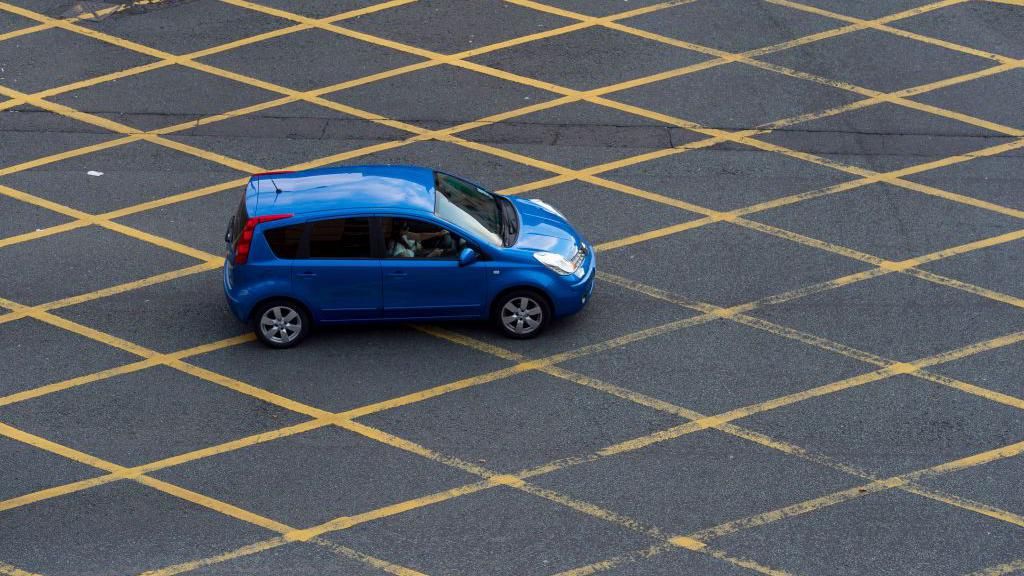Some yellow box junctions too big, says RAC

Drivers are not permitted to enter yellow boxes unless their exit is clear or they are waiting to turn right
- Published
Nearly all of the yellow box junctions which generate the most fines in Cardiff and London are larger than necessary, the RAC has said.
Yellow boxes are used to help the smooth running of traffic through busy junctions, with drivers not permitted to enter unless their exit is clear or they are waiting to turn right.
But motorists risk being "fined unnecessarily" when their actions "haven't contributed to congestion”, according to the motoring body.
Cardiff council said each junction box was "designed to legal requirements" and changing them would be a "fundamentally flawed" move.
- Published23 August 2023
- Published4 August 2023
In Cardiff, the yellow box junctions between Churchill Way and Bute Terrace, as well as between Dumfries Place and Newport Road, were found to have 68% and 61% of their areas serving no purpose respectively.
The former generated more than 9,000 fines in 2019.
The yellow box at the junction between Dumfries Place and Newport Road in Cardiff is bigger than needed, according to the RAC
In London, the highest-fined boxes in 2019 were between Talgarth Road and Butterwick (25,681 fines), under the Hammersmith and Fulham local authority, followed by Transport for London's (TfL) box at Wandsworth Fire Station (18,040 fines).
Engineer Sam Wright was commissioned by the RAC to analyse the 100 boxes across Cardiff and London which were responsible for generating the most fines in 2019.
He found 98 of them to be larger than necessary for their role in preventing queuing vehicles blocking the path of crossing traffic.
'Penalties are going to mushroom'
The RAC is calling on the government to update guidance, making clear where and how yellow boxes should be used.
Roads are a devolved issue in Wales, meaning they are overseen by the Welsh government.
Rod Dennis of the RAC said: "We fear that unnecessary penalties are going to mushroom in the coming years as more councils start enforcing yellow boxes, unless a responsible approach to the design and enforcement of them is taken."
In Cardiff, the fine for being caught in the box is £70, reduced to £35 if paid within 21 days.
It is the same rate in England, outside of London, but on TfL red routes - which carry 30% of the city's traffic - the fine is £160, reduced to £80 if paid within 14 days.
The penalty is £130, reduced to £65 if paid within 14 days, on roads managed by London boroughs.
Mr Wright said even "a car bumper overhanging part of a box" could result in a fine.
"Yet in so many cases, drivers can't avoid stopping in them - a good example being where a yellow box is so big that a driver can't see where it ends," he said.
Will councils now change yellow boxes?
The Department for Transport said it was "committed to ensuring councils don't unfairly penalise motorists to raise revenue, and are reviewing our guidance around yellow boxes to tackle overzealous enforcement".
Cardiff council said "each junction box is designed to legal requirements and recommendations, with issues around traffic blockages which may be caused by specific factors at the junction factored into the designs".
It cited the car park exit from St David's 2 shopping centre on to Bute Terrace as an example of this case-by-case consideration.
"Drawing up junction boxes without this key data, and without understanding where traffic is coming from and what might be causing issues which need remedied to ease congestion and improve traffic flow, we believe is fundamentally flawed."
It said the example given by the RAC of how a box could be redrawn, external followed an "irregular pattern" and would not be allowed.
The Welsh government said the issue was a matter for Cardiff council.
A spokesperson for TfL said: “Yellow box junctions play a vital role in keeping traffic in London moving and enforcement of the rules helps to reduce delays and keep people travelling safe.
"All yellow box junctions in London are designed with these purposes in mind and we disagree with these findings. We continue to keep our road markings well maintained to ensure drivers are treated fairly.”
Related Topics
- Published18 July 2023
- Published28 June 2023
- Published20 February 2023